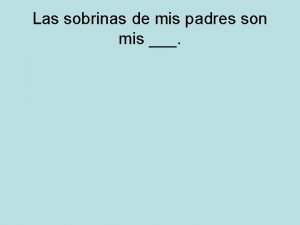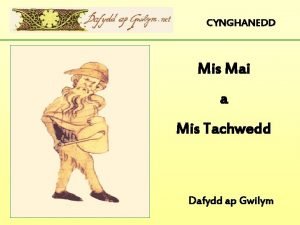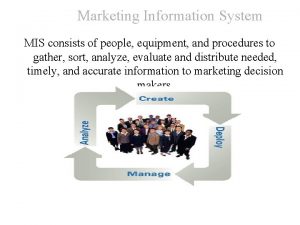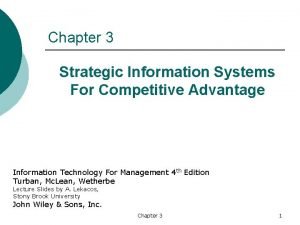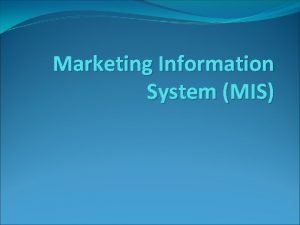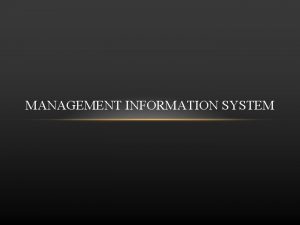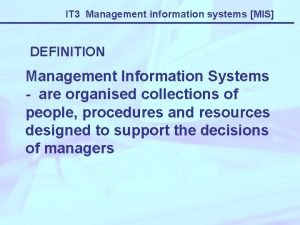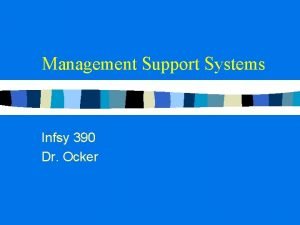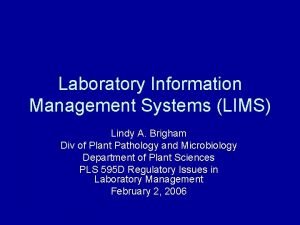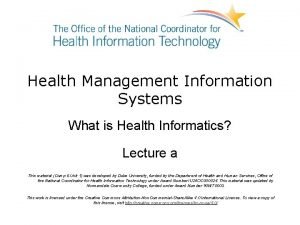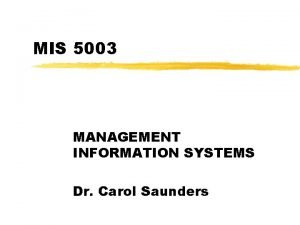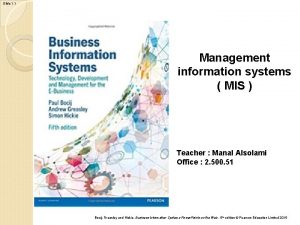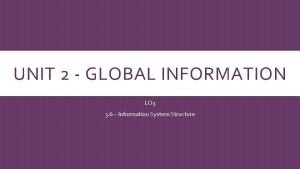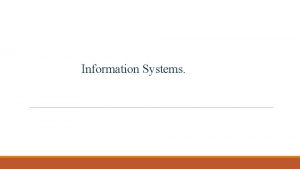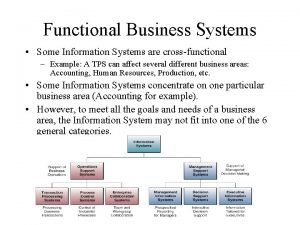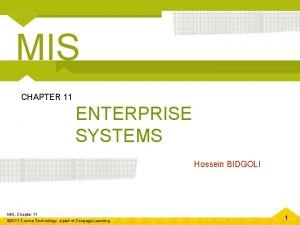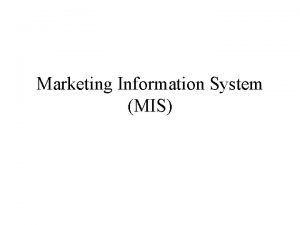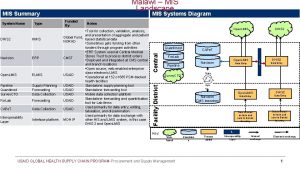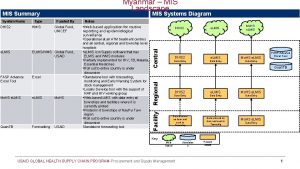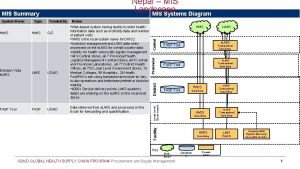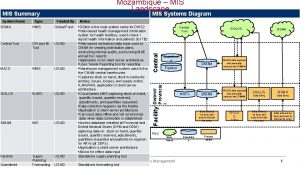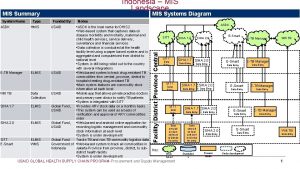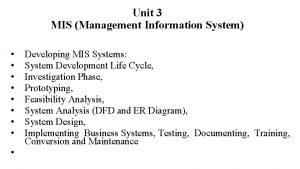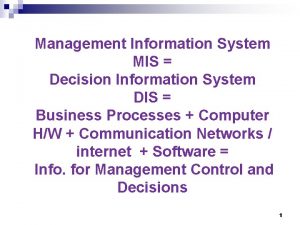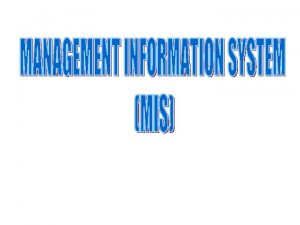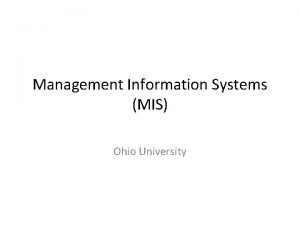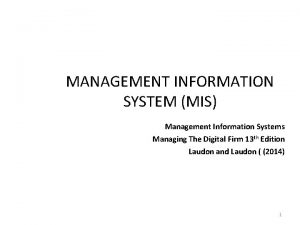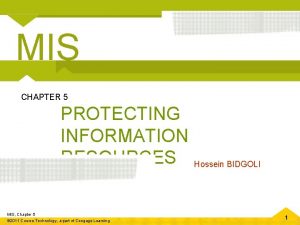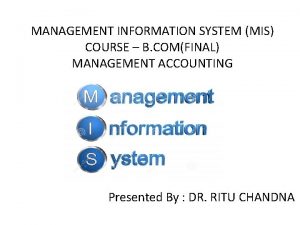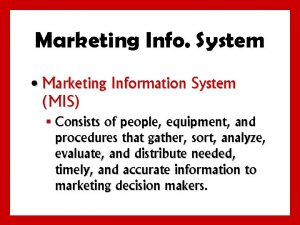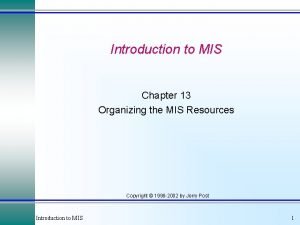Management Information System Definition of MIS Management information
























- Slides: 24

Management Information System

Definition of MIS Management information system, or MIS, broadly refers to a computer-based system that provides managers with the tools to organize, evaluate and efficiently manage departments within an organization.

MAIN PURPOSE OF MIS To provide useful and timely information to help mangers make decisions at all levels.

TYPES OF MANAGEMENT INFORMATION SYSTEM 1. Transaction Processing System 2. Operations Information System (also referred to as Management Information System) 3. Decision Support System 4. Office Automated System

TRANSACTION PROCESSING SYSTEM These systems are designed to handle a large volume of recurring transactions on a daily basis. ◦ Supermarkets use them to record sales and track inventory. ◦ Most managers use these systems to deal with tasks such as payroll, customer billing and payments to suppliers.

SAMPLE TRANSACTION

OPERATIONS INFORMATION SYSTEM OR MIS An operations information system gathers comprehensive data, organizes it and summarizes it in a form that is useful for managers. For example, a report. Managers use operations information systems or MIS to obtain sales, inventory, accounting and other performance-related information.

REPORT produced by MIS

DECISION SUPPORT SYSTEMS A decision support system (DSS) is a computer program application that analyses business data and presents it so that users can make business decisions more easily. A decision support system may present information graphically. For example, ◦ Comparative sales figures between one week and the next ◦ Projected revenue figures based on new product sales assumptions

COLUMN CHART – BUSINESS PERFORMANCE – DEC 8 TO MAR 1

MANAGEMENT INFORMATION SYSTEMS Top Level – set policies Middle Managers– set procedures Low Level – carry out operations

SAMPLE MANAGEMENT INFORMATION SYSTEM

BENEFITS OF MIS ØSave on time – information more easily available ØSave on money – less working hours spent to retrieve data ØSave on labour – less persons needed to prepare reports and organize files

BENEFITS OF MIS ØIncrease profit margins – money is retained in the business is less it spent. ØIncreased competitiveness – the business will have more accurate

Challenges with MIS ØDevelopment costs ØTraining costs ØSecurity issues – virus, hackers, computer crash

PERSONAL NEEDS SATISFIED THROUGH EMPLOYMENT

What are your needs? List ANY five personal needs you think you should have?

MOTIVATIONAL THEORIES Human behavioural theorists have produced a number of theories (beliefs) to explain what motivates individuals to act in a particular manner. These theories are very useful to managers since they explain what drives the average person to a greater performance.

MOTIVATIONAL THEORIES Maslow’s Hierarchy of Needs Maslow (1943) stated that people are motivated to achieve certain needs and that some needs take precedence over others. Our most basic need is for physical survival, and this will be the first thing that motivates our behaviour. Once that level is fulfilled the next level up is what motivates us, and so on.

MASLOW’S HIERARCHY OF NEEDS Maslow believed that need of humans could be classified into five basic needs, often shown as hierarchical levels within a pyramid.

Managers must be aware of the various needs of workers. If these needs are adequately satisfied through work, then workers will be motivated to improve performance. Basic Needs Employment is very important for the economic survival of individuals. If employees receive adequate pay then these needs will be satisfied. Some employees may also receive allowances and fringe benefits. Once the basic needs of survival (food, clothing and shelter) are met, employees will be aware of higher level needs.

Security Needs A job should not only provide adequate pay to satisfy basic needs but it should also give workers security. This need can be satisfied through the provision of health benefits, insurance and pensions. Social Needs The employee spends on average eight hours each day at work. We are social beings and therefore need human interaction. This need can be satisfied by the establishment of after work activities and through a teamwork approach to accomplishing tasks.

Self-Esteem Needs Managers can satisfy this need through promotion and ways of recognizing those who have performed well. Self-actualizing Needs This need is satisfied by giving subordinates opportunities to create and pursue innovative ideas so that they can realize their capacities to the fullest.

Question 1. Explain the term motivation 2. In Maslow’s theory, there is a ‘hierarchy of needs’. State these five needs.
 Visión personal proyecto de vida
Visión personal proyecto de vida El hijo de mi hermana es mi ____
El hijo de mi hermana es mi ____ Mis mai a mis tachwedd
Mis mai a mis tachwedd Mis mai a mis tachwedd
Mis mai a mis tachwedd Mis actos son un reflejo de mis creencias
Mis actos son un reflejo de mis creencias Internal records in marketing
Internal records in marketing Example of management information system
Example of management information system Strategic information system for competitive advantage
Strategic information system for competitive advantage A marketing information system mis consists of
A marketing information system mis consists of A marketing information system mis consists of
A marketing information system mis consists of Management information systems (mis)
Management information systems (mis) Dr ocker
Dr ocker Laboratory information management system definition
Laboratory information management system definition Shortliffe
Shortliffe Health management information system definition
Health management information system definition Data vs information in mis
Data vs information in mis Information quality in mis
Information quality in mis Importance of rest
Importance of rest Difference between open and closed system in computer
Difference between open and closed system in computer Transaction processing system in mis
Transaction processing system in mis Explain functional business systems
Explain functional business systems Tps information system examples
Tps information system examples Expert system in mis
Expert system in mis Enterprise system in mis
Enterprise system in mis Words with mis prefix
Words with mis prefix

